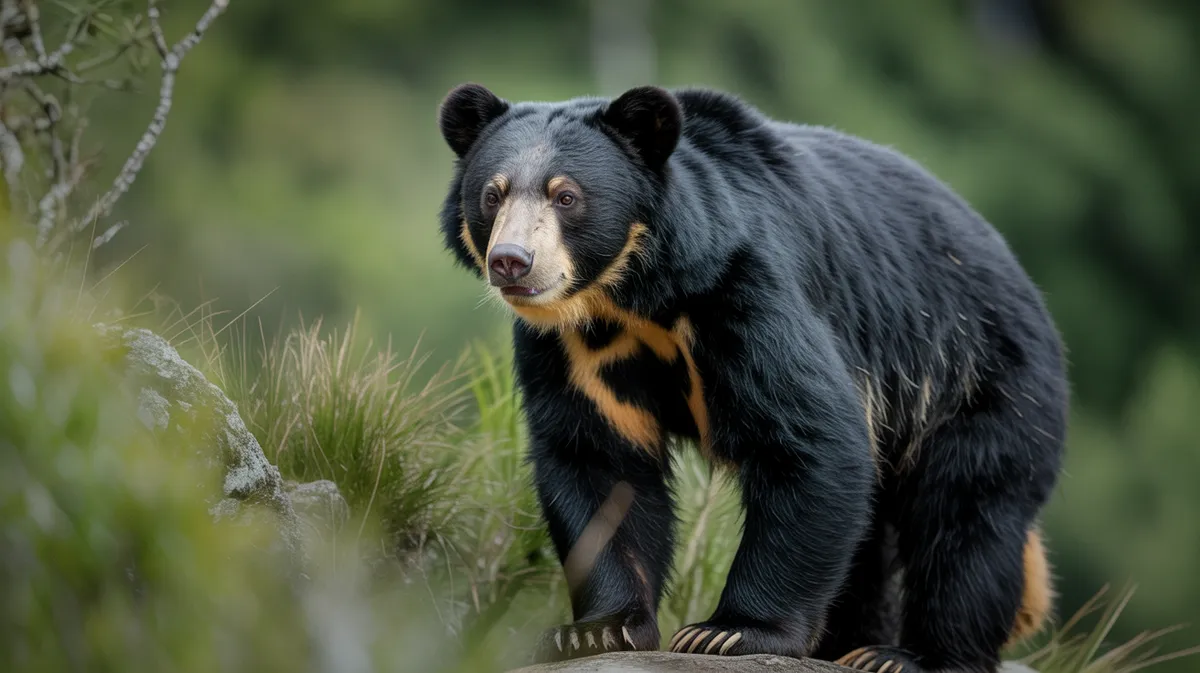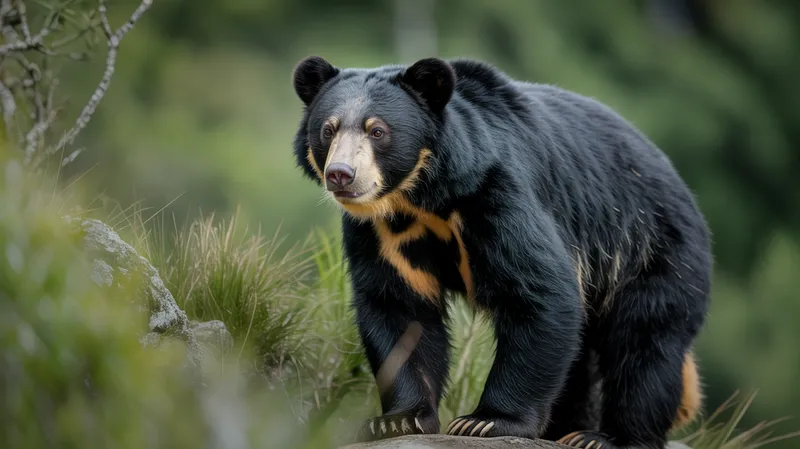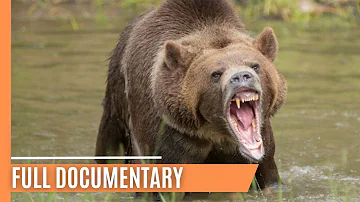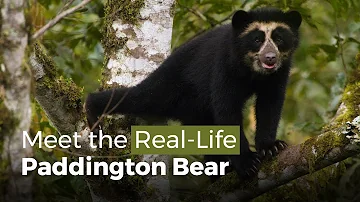
Andean Bear
Tremarctos ornatus

Meet the Andean Bear
The Andean bear, also known as the spectacled bear, is South America's only bear species and is distinguished by its shaggy black fur and unique facial markings, which often resemble eyeglasses. This elusive mammal inhabits the remote cloud forests and mountainous regions of the Andes, ranging from Venezuela to Bolivia. Andean bears are excellent climbers and spend much of their time in trees, where they search for fruits, bromeliads, and occasionally small animals. Their solitary and secretive nature, combined with habitat loss, makes them one of the lesser-seen large mammals of their range.
Classification
Mammal
Habitat
Cloud forests and Andean mountains
Diet
Omnivore
Lifespan
20-25 years
Conservation
Vulnerable
Weight
60-175 kg
📖Fascinating Facts
Spectacled Appearance
The Andean bear gets its nickname 'spectacled bear' from the light-colored markings around its eyes that resemble eyeglasses.
Tree Dwellers
They are highly arboreal and often construct platforms in trees to rest or eat, a rare behavior among bears.
Mostly Herbivorous
Although they belong to the Carnivora order, their diet is primarily composed of fruits, leaves, and other vegetation.
📋Detailed Description
The Andean bear (Tremarctos ornatus), also known as the spectacled bear, is a medium-sized bear species with adult males typically weighing between 100 and 200 kg (220–440 lbs), while females are significantly smaller, averaging 60–80 kg (130–175 lbs). Their dense, shaggy fur is predominantly black, though brown and reddish hues are sometimes observed, and distinctive pale markings encircle the eyes and muzzle, giving rise to their common name. These markings are highly variable between individuals and can extend onto the chest. The Andean bear has a short, broad snout and powerful jaws, adaptations for processing tough plant material. Its limbs are strong and equipped with curved, non-retractile claws, making it an adept climber—an unusual trait among bears. Primarily solitary, individuals maintain large home ranges, with males' territories overlapping those of several females. The species is crepuscular, most active at dawn and dusk, and spends considerable time foraging in the forest canopy. Andean bears are highly adaptable, occupying habitats from humid montane cloud forests at 500–4,700 meters elevation to dry forests and high-altitude grasslands (paramos). They are opportunistic feeders, with a diet dominated by fruits, bromeliads, palm hearts, and cactus, but will also consume insects, small mammals, birds, and carrion. Their elusive nature and preference for dense vegetation make them difficult to observe in the wild. Reproduction is seasonal, with cubs born in concealed ground nests or tree hollows. The species is the last extant member of the short-faced bear subfamily (Tremarctinae), a lineage that once included giant prehistoric bears.
💡 Did you know?
Despite being classified as carnivores, up to 85% of the Andean bear's diet is plant-based.
🔬Research & Sources
Wikipedia Summary
The spectacled bear, also known as the South American bear, Andean bear, Andean short-faced bear or mountain bear and locally as jukumari, ukumari (Quechua) or ukuku, is a species of bear native to the Andes Mountains in northern and western South America. It is the only living species of bear native to South America, and the last remaining short-faced bear. Unlike other omnivorous bears, the diet of the spectacled bear is mostly herbivorous. The species is classified as Vulnerable by the IUCN because of habitat loss.
Last Modified: 6/2/2025
🎭Behavior & Social Structure
Andean bears are primarily solitary, except during mating season or when females are accompanied by cubs. They are highly arboreal, often constructing platforms or nests in trees both for feeding and resting. Their foraging behavior is characterized by meticulous searching for fruits and bromeliads, which they skillfully extract using their strong jaws and dexterous forelimbs. They have been observed peeling back bark and breaking open bromeliads to access the nutritious core. While generally herbivorous, they may prey opportunistically on small mammals, birds, or livestock, especially in fragmented habitats. Andean bears are known for their secretive and cautious nature, often avoiding human contact. They mark their territory with scent and by clawing tree trunks. Daily activity peaks at dawn and dusk, but activity patterns may shift in response to food availability or human disturbance.
👶Reproduction & Life Cycle
Andean bears exhibit a polygynous mating system, with males seeking out estrous females during the breeding season, which typically occurs from April to June, though timing may vary with latitude and elevation. After mating, delayed implantation occurs, with the fertilized egg remaining dormant before implanting in the uterus. Gestation lasts approximately 5.5 to 8 months, including the delay, and cubs are born between December and February. Litters usually consist of one to three cubs, each weighing about 300–330 grams at birth. Cubs are altricial, blind, and dependent on maternal care. The mother raises the cubs alone, providing protection and nourishment for up to one year, though cubs may remain with the mother for up to two years. Sexual maturity is reached at 4–7 years, and reproductive intervals are typically two to three years, depending on cub survival.
🛡️Adaptations & Survival
The Andean bear displays several unique adaptations for its montane and arboreal lifestyle. Its strong, curved claws and flexible limbs facilitate climbing and foraging in the forest canopy. The broad, short snout and robust jaw musculature enable it to process tough, fibrous plant materials such as bromeliads and palm hearts. Its keen sense of smell aids in locating food sources over large distances. The thick, water-resistant fur provides insulation against the cool, damp conditions of cloud forests and high-altitude habitats. Behavioral flexibility, including dietary opportunism and the ability to exploit a range of habitats from dense forests to open grasslands, enhances its survival in fragmented and changing landscapes.
🎨Cultural Significance
The Andean bear holds significant cultural value in Andean societies, where it is featured in folklore, mythology, and traditional beliefs. In Quechua and Aymara cultures, the bear (jukumari, ukumari, or ukuku) is often regarded as a symbol of strength, wisdom, and a mediator between the natural and spiritual worlds. In some legends, the bear is believed to be an ancestor or a shapeshifter. The bear also appears in local festivals and dances, such as the 'Ukukus' in Peru, where performers dressed as bears play protective roles. Despite occasional conflict, the species is respected and sometimes protected by traditional taboos against hunting.
🔬Recent Research & Discoveries
Recent research has focused on the Andean bear's genetic diversity, habitat use, and movement patterns using camera traps, GPS telemetry, and non-invasive genetic sampling. Studies have revealed that the species requires large, contiguous habitats for viable populations and that genetic connectivity is threatened by increasing fragmentation. Dietary studies using stable isotope analysis confirm the predominance of plant material in the diet, with seasonal shifts to more animal matter during resource scarcity. Ongoing research includes the impact of climate change on food plant phenology and the effectiveness of community-based conservation initiatives. Notably, the Andean bear serves as an umbrella species for Andean ecosystem conservation, with its protection benefiting a wide range of co-occurring flora and fauna.
🎥Wildlife Videos

Inside the World of Bears | Full Documentary
Venture into the wild to meet the amazing Bear family … some of the largest, strongest mammals roaming the planet.
Free High-Quality Documentaries

The Enigmatic Bear of South America, the Andean Bear
The Andean bear, also known as the spectacled bear, is the only bear species native to South America. Mysterious, elusive, and ...
Wild Curiosities 🌍

The Secret life of Spectacled Bear | SLICE WILD | FULL DOC
The spectacled bear, the most mysterious plantigrade on the planet, lives on the high plateaus of the Andes. For the first time, ...
SLICE Wild

New data sheds light on elusive Andean bear
National Geographic researchers used GPS-enabled cameras to see how Andean bears interact in the wild for the first time.
USA TODAY

Saving South America’s Only Bear Species | National Geographic
The Andean bear, also known as the spectacled bear, is sometimes called the Paddington bear, after the fictional bear in ...
National Geographic

Meet the Real-Life Paddington Bear
“Bears“ premieres Wednesday, November 20 at 8|7c on PBS --------------- For full NATURE episodes, check out ...
Nature on PBS
🌍Habitat Information
The Andean Bear typically inhabits Cloud forests and Andean mountains environments. Andean Bears have adapted to their environments with specialized features and behaviors.
Primary Habitat:
Cloud forests and Andean mountains
More detailed habitat information will be available soon.
🛡️Conservation Status
The Andean Bear is currently classified as Vulnerable. Conservation efforts are crucial for preserving this species for future generations.
Common Threats:
- 🏠Habitat loss and fragmentation
- 🌡️Climate change impacts
- 🎯Hunting and poaching
- 🏭Human-wildlife conflict
⚠️Threats & Conservation Challenges
The primary threats to the Andean bear are habitat loss and fragmentation due to agricultural expansion, cattle ranching, mining, and infrastructure development. Illegal hunting and retaliatory killings occur when bears prey on livestock or are perceived as threats to crops. Habitat fragmentation isolates populations, reducing genetic diversity and increasing vulnerability to stochastic events. Climate change poses additional risks by altering the distribution of key food plants and suitable habitats. Population estimates are uncertain but suggest fewer than 10,000 mature individuals remain, with a declining trend. Conservation challenges include limited protected area coverage, insufficient law enforcement, and lack of public awareness.
🔬Scientific Classification
Scientific Name
Tremarctos ornatus
Classification Hierarchy
🔍 About Taxonomic Classification
Taxonomic classification is a hierarchical system used by scientists to classify and organize living organisms based on shared characteristics and evolutionary relationships.
The system moves from broad categories (Kingdom) to increasingly specific ones, with each animal's scientific name typically consisting of its Genus and species.
📝Community Notes
Share your observations and insights about the Andean Bear with our community of wildlife enthusiasts.
Join Our Community
Sign in to share your observations and connect with fellow wildlife enthusiasts.
Sign In to ContributeNo community notes yet
Be the first to share your observations about the Andean Bear!
Explore Andean Bear
Select a tab above to learn more about this amazing animal.
📸Photo Gallery
No photos available for this animal yet.
🌟Discover More Wildlife
Continue your journey of discovery with more fascinating animals from our database
